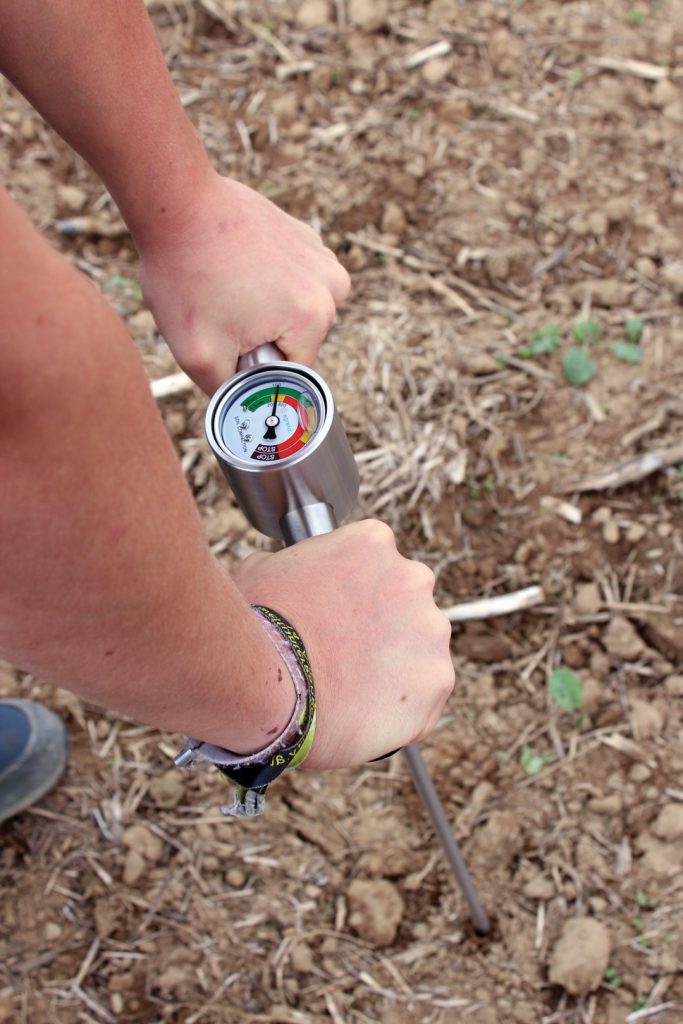TRASH TALK
BY LEE HART • PHOTO COURTESY OF LESLEY KELLY
In the past growing season Mike Ammeter encountered “sort of a mystery” on his farm near Sylvan Lake. He seeded malt barley into wheat, canola and pea stubble and lightly harrowed it. “It seemed to emerge OK,” said Ammeter. But by the end of June the crop was quite uneven. Though he’s not certain, he has a guess as to the cause. “It might have been something to do with two-and-a-half inches of rain right after seeding, along with fairly heavy crop residue on the ground.”
One hundred-bushel wheat was unheard of 15 years ago, but today’s higher yielding cereal varieties can come with increased plant size. Heavy crop residue, or trash, in combination with excess moisture has implications for direct seeding and conservation farming practices. In certain parts of Alberta, excessive crop residue is a complicating agronomic factor and it has become a topic of discussion among farmers.
If the timing works out and conditions warrant, Ammeter usually follows combining with a light harrow to distribute residue. Spring is the next best option, he said. Given the unevenness of his crop in June, he may adjust the straw chopper on the combine. “I have it set pretty fine so it’s almost like a powder on the soil surface,” he said. “That doesn’t move very much when I harrow. Perhaps the setting should be coarser so the harrows can actually move the residue.”
Near Rycroft in the Peace Region, Warren Sekulic said excess moisture probably contributed to one of the poorest crops he’s had in 10 years, although he appreciates that other areas of the province had it much worse. Once Sekulic’s crop began growing through heavy crop residue it was hit with 13 centimetres of rain over a couple of days, followed by hail in places. This set it back substantially. “I’m a firm believer in zero-till farming, although I’m not a zealot either,” he said. “We plan to direct-seed everything, but I will apply some tillage if needed.”
Cropping about 4,300 acres, Sekulic grows peas, wheat, oats and canola in rotation. His major crop residue management practice, particularly in cereal crops, is to cut stubble as tall as possible. He also keeps the combine’s chopper knives sharp and replaces them every couple years. Tall stubble that is anchored to the soil allows his disk drill to better work through residue at seeding.
Dave Davidson farms near Joffre, 30 kilometres northeast of Red Deer. To better manage heavy crop residue, he uses the combine to chop and spread chaff over a wide area. Ideally, on cereal and pea stubble fields, he follows harvest with a heavy harrow.
He leaves canola stubble as tall as possible at harvest and will heavy harrow the crop in the spring to distribute residue and expose a bit of soil to warm the seedbed. “On the cereal and pea fields I prefer to harrow in the fall,” said Davidson. “But due to late harvest last year, that didn’t get done. To heavy harrow in the spring ahead of seeding helps, but it’s not as good. There is better breakdown of crop residue if I can get it done in the fall.” He seeds the crop in one pass with a Bourgault drill equipped with mid-row banders for fertilizer placement.
Jay Bruggencate, who farms near Lacombe, believes in zero-till farming, but has incorporated tillage to help manage excess moisture and heavy crop residue. “For many years I was passionate about direct seeding and zero-till,” said Bruggencate. “But in the past three or four growing seasons we’ve had high moisture and big crops with high residue. And wet conditions during a late harvest doesn’t help. The straw is tough and it doesn’t chop as well, and there can be a lot of starting and stopping so the residue isn’t spread as even as it should be.”
Bruggencate said he has had to “pivot on his strategy” to manage residue. He grows high-yielding crop varieties but also looks for those with shorter stature or semi-dwarf characteristics. If circumstances are right, he’ll bale at least some crop residue to remove straw from the field. And he’s also considering fall banding of fertilizer to take some pressure off at seeding time and to help with residue management.
He has heavy harrowed fields in the fall, but in recent years he has worked fields with a high-speed disc. “Mainly it is to manage that heavy residue, work it into the soil and prepare a good seed bed for quick crop emergence,” said Bruggencate. “We grow malt barley often seeded into canola stubble, so getting that soil exposed and warmed up is important to get a quick and even emergence on the crop.”
Bruggencate said while tillage produces benefits there are trade-offs. With tillage, he can better manage heavy residue and expose some black soil. This improves crop germination and gets the crop up and growing with emergence “about a week to 10 days earlier than if it had to work its way through undisturbed crop residue,” he said.
On the flip side, he said disc tillage along with straw removal by baling takes its toll on soil organic matter and reduces the soil’s water holding capacity. Disturbing the soil will also affect development of soil biology. Bruggencate has also seen recent soil tests that indicate baling and removing straw will reduce potash and phosphorus levels in the soil. “I don’t consider baling straw a sustainable practice,” he said.

Earth Dirt Soil agronomics consultant Elston Solberg said direct seeding and conservation farming remain worthwhile objectives, but zero-till shouldn’t be viewed as a sacred cow. Solberg advises farmers consider “intelligent tillage” as part of a strategy to keep soils productive, manage crop residue and make nutrients available to increase yields.
“We have advocated direct seeding and minimum tillage for more than three decades,” said Solberg. “And while there are many benefits, I have also pointed out it can be detrimental as well. But the use of tillage as a management tool is a message that hasn’t been well received by a limited and unappreciative audience.”
Solberg said research shows a straight zero-till system can lead to shallow depth soil compaction. It can also create stratification of important but less mobile crop nutrients. This keeps them out of the crop root zone. As well, undisturbed crop residue can, over multiple years, can lead to cold soils, increased moisture retention and slow crop emergence.
Solberg suggested various treatments can help manage residue and benefit crop growth. Occasional baling to remove straw will reduce the buildup of crop residue. Fall banding fertilizer is a lesser used practice these days, but it gets nutrient application out of the way prior to seeding and opens up the soil profile. And he also suggested the occasional deep tillage pass.
“Research shows that a tillage operation can be a positive,” said Solberg. “Am I advocating a fairly heavy tillage every year? No. But can tillage be applied once every five or 10 years, perhaps to open up the soil profile and improve crop productivity?
Probably, yes. I think it has to be looked at as intelligent tillage. As an occasional treatment it can help make soils more productive.” Solberg said occasional tillage can distribute crop residue and expose the soil surface so it warms to improve crop germination.
Tillage also helps break up the shallow soil compaction layer so crop roots and moisture can penetrate deeper. And the disturbance can help immobile nutrients such as phosphorus and potassium move deeper into the soil profile so they are available to crop roots.
“I know there are several producers in Alberta who are achieving 100-bushel wheat crops, 130-bushel barley crops and 70- to 80-bushel canola crops,” said Solberg. “And one of the keys to these higher yields is occasional tillage.”
To determine the potential value of tillage, Solberg suggested two options. A penetrometer can measure the existing degree of soil compaction, and a standard soil test can evaluate nutrient levels in the two top two to six inches.
These farmers and agronomists agree it is important to apply common sense regarding tillage and to follow conservation farming practices. They also suggest there may be a place for intelligent tillage to manage heavy residue and improve crop performance.
RESIDUAL ISSUES
TILLAGE LIMITATIONS
Agriculture and AgriFood Canada plant pathologist Kelly Turkington points out tillage is not useful in reducing crop diseases. “Many studies have shown that tillage does not reduce disease levels in crops,” said Turkington. “In fact, in some studies it appeared that tillage might have made matters worse.” He cited a cereal grain root rot study in which disease levels were greater in plots where conventional tillage was applied. He suspects the more vibrant soil microbiology in the study’s minimum tillage plots assisted in disease control.
Using a disc or cultivator on a field with heavy crop residue would have little or no impact in reducing disease, he said. This proved to be the case in a study he led on disease levels in wheat and barley. “There is potential for residue-borne cereal leaf diseases to be effectively managed under conservation tillage by the use of sound rotations, agronomic practices and careful choice of variety,” he said, summarizing the study’s conclusion.
VARIETY SELECTION
Shorter stature or semi-dwarf cereal crop varieties can help with residue management. Breeders do their best to help farmers manage residue, said Pat Juskiw, a barley breeder with the Alberta Agriculture and Forestry’s Field Crop Development Centre in Lacombe. “Certainly, in breeding cereal crops there are two important aspects that are kept in mind,” said Juskiw. “That includes developing varieties that have higher yield with the same amount of plant biomass.” This process is referred to as increasing the harvest index of a variety.
“The other aspect breeders consider, when possible, is to develop higher yielding but shorter stature varieties,” said Juskiw. “It can be a two-fold approach—higher yield with the same plant biomass and shorter or semi-dwarf varieties.”







Comments